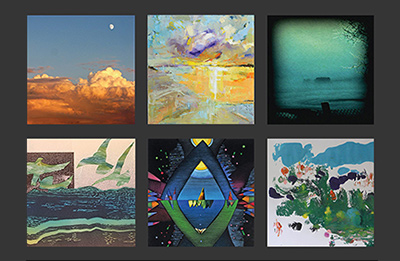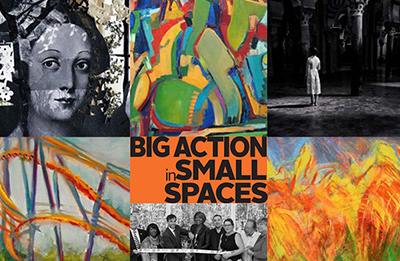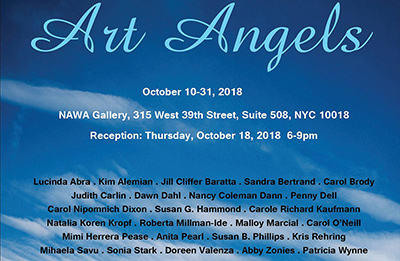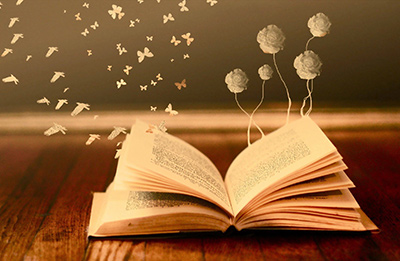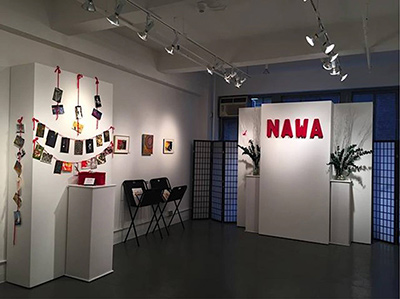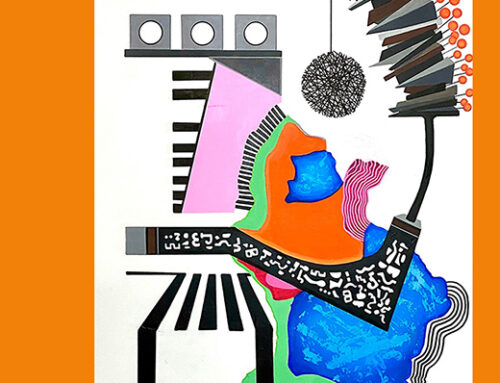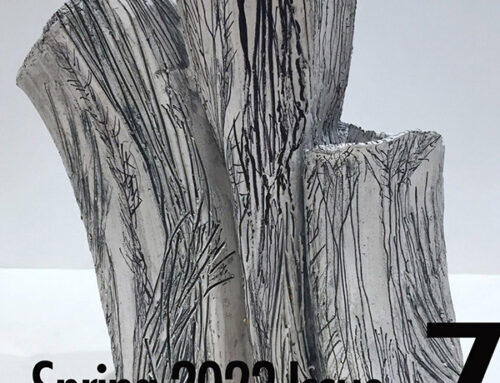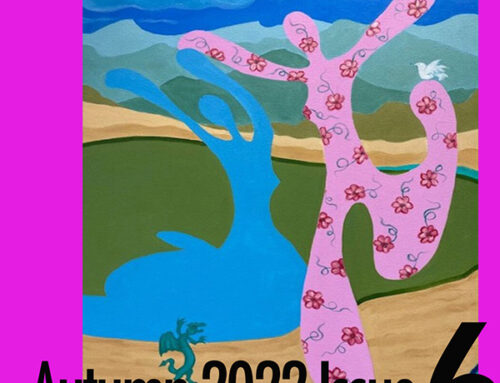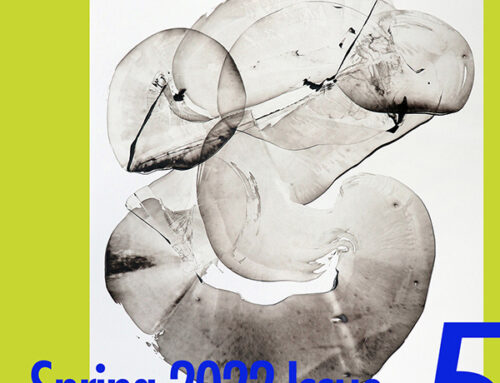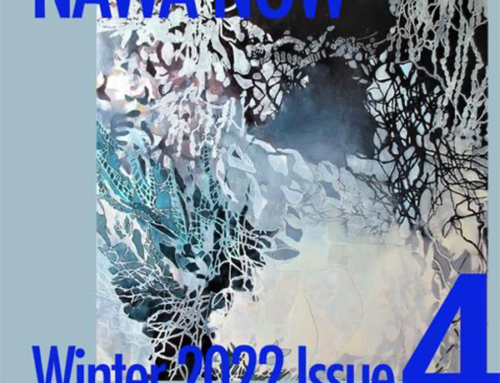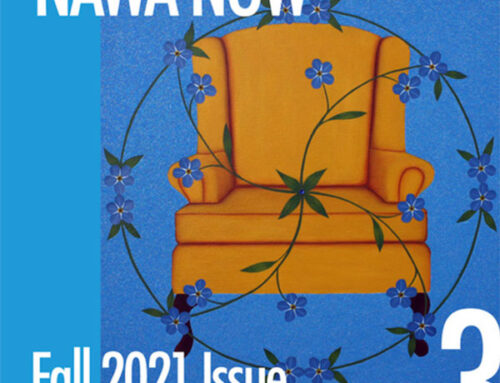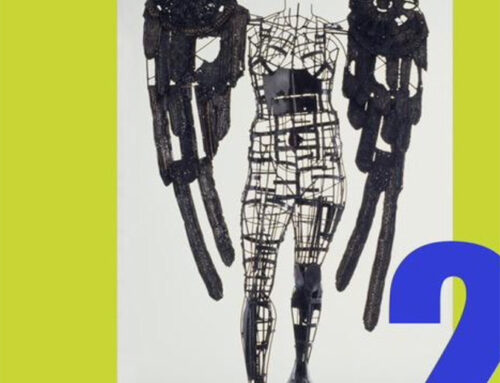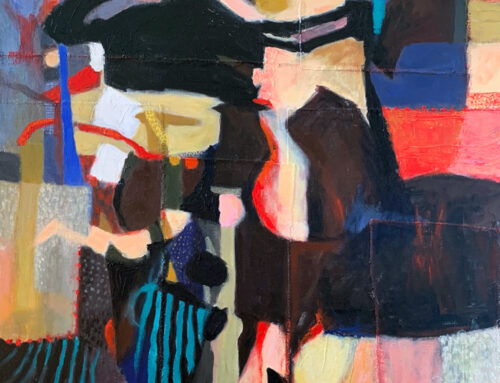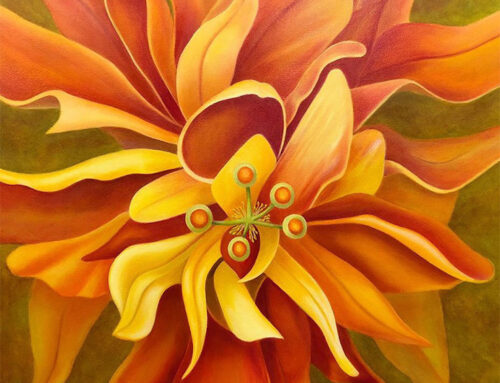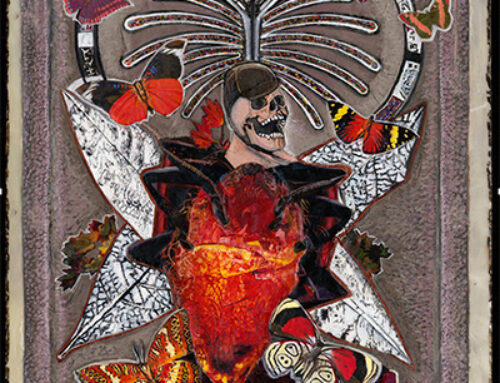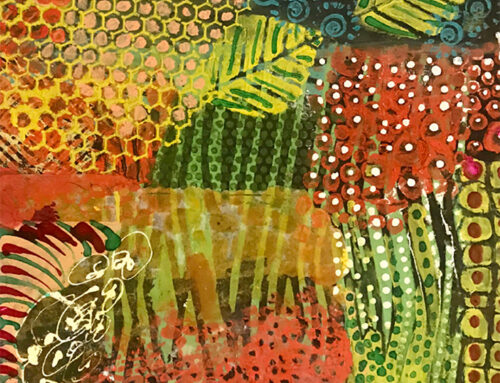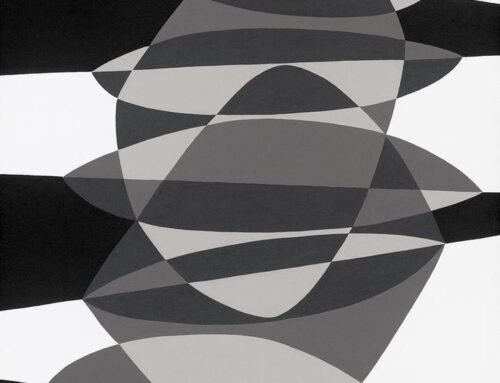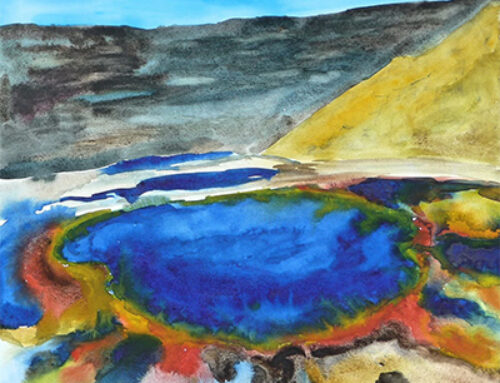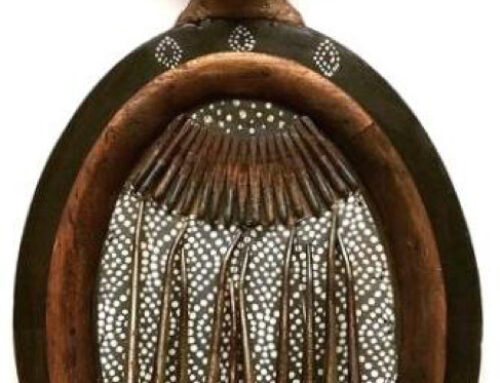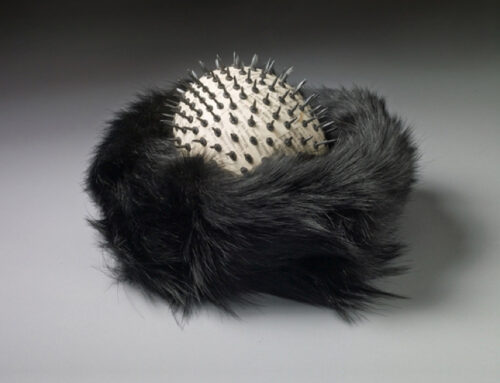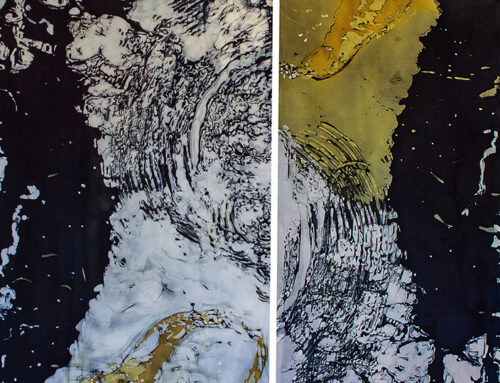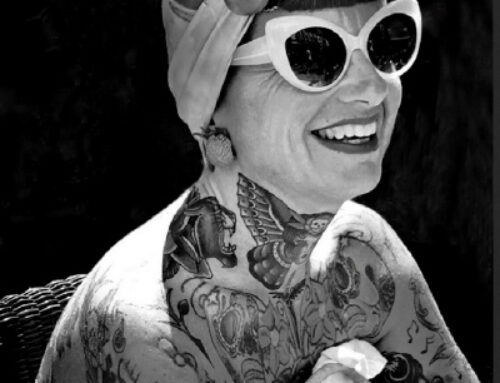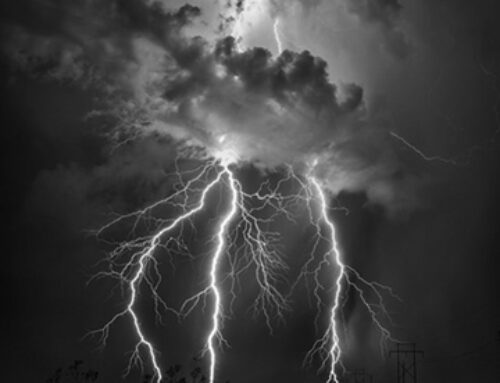
October 2018
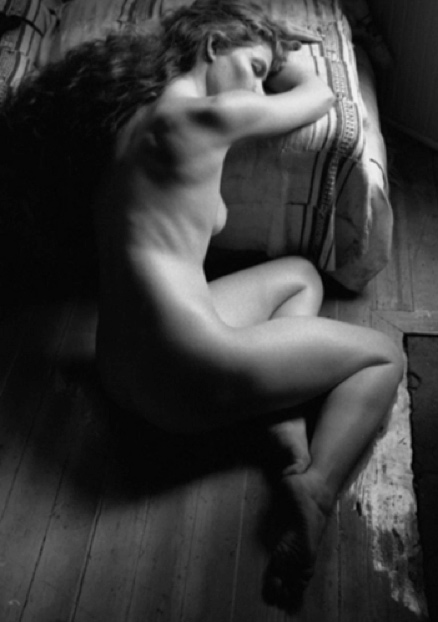
Clea, Black & White Photograph, © Susan G. Hammond
ABOUT Clea
My photograph is entitled Clea. Clea is a wonderful model who worked with me over a few summers. I have always loved working with the nude in the landscape, but this particular image was taken in an historic house in upper New York State. I did a lot of photography work at this house (inside and out). My goal has always been to capture metaphors or moods with my black and white images, rather than just an image, and the use of color – where the color takes over and the mood is overshadowed.
I always try to accomplish a relationship with the models I hire, so they understand me and I understand them. Posing is another issue because I want a specific mood and also proper lighting to capture the body in a romantic yet contemplative mood.
PRESIDENT’S CORNER
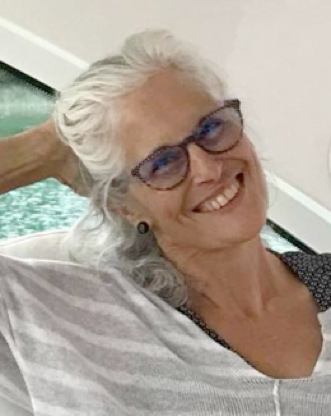
Jill Cliffer Baratta, President, NAWA
By the time you see this, the NAWA 129th Annual Members’ Exhibition will be in progress. We have all worked hard to put this together, hitting the “ground floor” running! In the 7 years since I’ve been a member, we have never had an exhibit in a ground floor gallery, so I think everyone is excited about the prospect of more potential walk-in traffic. It has been challenging to organize the space that we rented since the number of entries was so successful. But we’ve done our best, as always, to present a beautiful, salon-style exhibit everyone will enjoy. Catering will be done again by our friend Wilson, who is so gracious and talented with his team. It should be a lovely celebration of our excellence!
We are already fully booked for 2019 because we are anticipating our 130th Anniversary year. It is not easy to continue passing the torch and surviving intact for 130 years! It is an amazing accomplishment. We hope all hands will be on deck for our outside exhibitions plus an exciting lineup of open media-based exhibitions in our own NAWA Gallery in 2019. Please keep in touch and watch for more information and events coming up to help us celebrate. If you’re in the tri-state area, we always need your help in the gallery. So keep in touch for installation and deinstallation/packing schedules.
NAWA has several members now who live outside the New York headquarters area who are very actively participating in our association. Mimi Herrera Pease, for one, is one of our Newsletter editors, and she is in San Francisco! Our Public Relations Committee meets on Zoom.com, so we have members stoking interest in membership and exhibitions in outlying areas as well (Arkansas, Tennessee, and more). While the world of art has undoubtedly expanded to numerous vibrant local communities across the USA, we at NAWA are still a fighting force for women to have parity in the elusive and mercurial art market. Please consider how you can also contribute time, energy, word-of-mouth, and of course, funds. I have heard from many of you, and thank you for offering your skills and ideas. Please apply creativity to thoughts of how you can help. Fundraising knows no bounds (just saying!).
Speaking of sustainability, I have many conversations with members, volunteers and staff about NAWA and our future. It is very common for nonprofits to struggle to “make ends meet”, and we have managed to stay sustainable (with a little help from our friends). There’s no question about our relevance, our service and responsibility to exist, but we never know how things will shake out and could always use more financial help. Awards donations are important and serve as motivators for all of us, but we also need to continually keep our operating coffers going. We have outdated computers and New York City rent. You get the picture: Real estate is skyrocketing, and exhibitions costing more for less time. The art market shifts dramatically, having moved around from Soho, to Chelsea to Brooklyn and beyond. However, we’re still here, working extremely hard with a super small staff doing a large amount of work. We need to engage our younger members to start learning the ropes to keep it all going. So, I’m just throwing those thoughts out there to let you know what your president is thinking about besides our 130th Anniversary—hoping for 135 and beyond (and a worthy successor this May!).
Please visit the NAWA Facebook page: wwww.Facebook.com/TheNAWA and click on “like” so you will be informed of all NAWA activities, events and interesting articles.
Yours in creativity,
Jill Cliffer Baratta, MFA
President, NAWA
NAWA – THE EARLY YEARS (1922-1938)
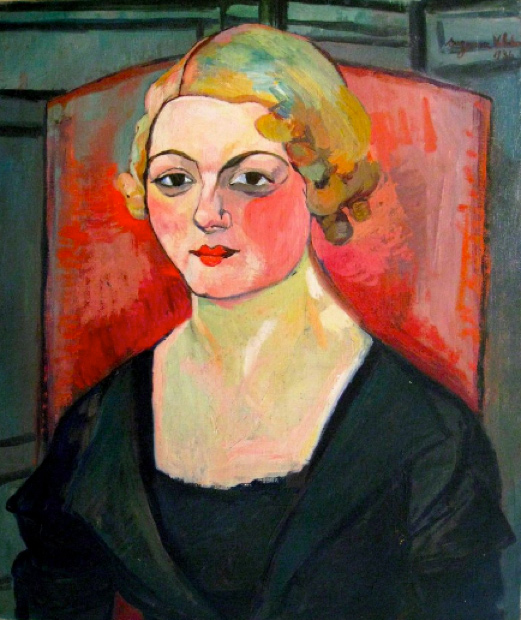
Suzanne Valadon, Portrait of Genevieve Camax-Zoegger, oil on canvas, 1936
The National Association of Women Painters and Sculptors
by Susan G. Hammond
When Emily Nichols Hatch became President in 1922, with a membership of 600, the annual dues were raised to $10. The organization had outgrown the small office at the National Academy of Design, and a proposal was made to raise funds to purchase a building that could be remodeled to provide a gallery, offices, living quarters and club rooms. The goal was achieved.
In 1924, an auction of paintings was held providing funds for a deposit on a house at 14 East 74th Street in NYC. This building was already equipped with a gallery. The owner withdrew the building from the market, but another location was found at 17 East 62nd Street. This house was purchased by the Association for $85,000. A first mortgage of $50,000 at 5% interest was taken out and a second mortgage of coupon bonds at 6% interested was issued for an additional $50,000 to cover the remainder of the purchase price and the cost of renovations.
The top floors were made into small apartments. The first floor was converted into a spacious gallery and the ground floor contained a kitchen and a restaurant. It was expected that the income from the apartment rentals and the restaurant concession would cover the expenses of the club house and meet the interest on the bonds and mortgage.
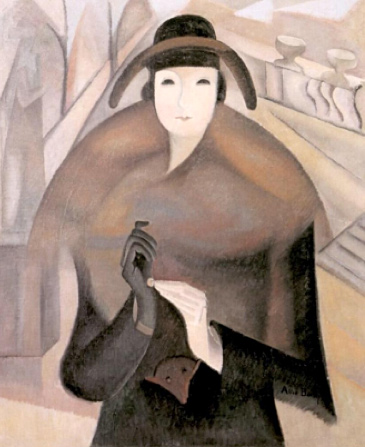
Alice Bailly, A Chilly Morning in Luxembourg, oil on canvas, 1922
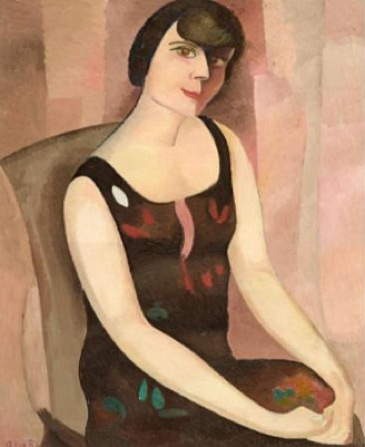
Alice Bailly, Portrait of Berthe Pique-Ramuz, oil on canvas, 1928
The club house formerly opened in the fall of 1925 – the first gallery in the U.S. devoted to the artwork of women artists. Enthusiasm grew, but the same year was the founding of the New York Society of Women Artists. Women from this group felt that the National Association of Painters and Sculptors had become too conservative, and that it was a social club rather than an association of professional artists. The new group was considered “women radicals” and considered the “left wing of the feminine artistic movement.”
The National Association of Women Painters and Sculptors felt that by exhibiting women’s art collectively they could promote an acceptance of, and appreciation for women’s art. By 1925, this goal was accomplished.
The mid 1920s-30s were productive years for the NAWPS. The clubhouse was very busy. Exhibitions abroad were organized, and in 1924 an exhibition of paintings, sculptures and miniatures were organized and traveled throughout South America under the patronage of the American Ambassadors to Argentina and Brazil. Exhibitions took place at the Museo Nacional de Bellas Artes, in Buenos Aires, and at the Galeria Jorge, in Rio de Janeiro.
The Association’s new headquarters held sketch classes, art demonstrations, lectures, and on a social level, weekly teas were provided for members and friends. However, the Association was dealing with growing debt during the years 1925-1930. Rentals of the apartments and gallery did not cover the overhead of the house and the interest on its mortgage and bonds. Zoning laws prevented the restaurant from becoming a profitable venture. In 1930 the building was sold for $50,000 over the purchase price paid by the Association. This sale allowed the Association to liquidate all of its debts just before the Great Depression. The sale of the house made it possible to redeem the bond issue, finance equipment for new headquarters and invest a substantial sum in an income bearing fund. The Association secured a favorable lease at 42 West 57th Street, in the heart of the New York art world. The Argent Galleries, which opened that year with a gala exhibition, reflected not only the continuing importance of the NAWPS, but the business acumen of its governing members as well.
The new space had two large daylight galleries where group exhibitions could be held all year. Berta Briggs a member of the organization expressed the Association’s philosophy, “While the large number of its members are of the more conservative school as is inevitable in a society which has been in existence for half a century, the Association welcomes the new movements in art and sees no reason why the traditional and radical are incompatible.”
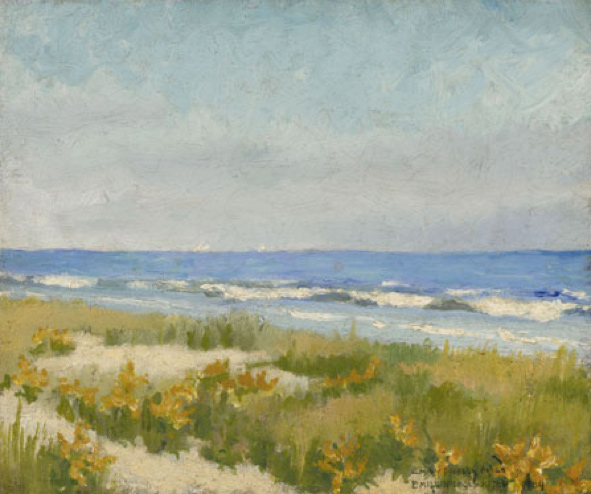
Emily Nichols Hatch, Goldenrod by the Sea, oil on canvas, Belle Harbor, NY, 1904
Despite the Great Depression, the Association survived, and in 1930, the organization had over one thousand members. In the following year the annual exhibition showed 218 oil paintings, 46 pieces of sculpture, 24 miniatures and 130 watercolors, etchings, lithographs and sketches. The New York Times critic Edward Alden Jewell praised the show, with some hesitation. He found the work “academic” with very little “pronounced modernism,” but he thought most of the work was sound and unpretentious, and was “imaginative conception and well carried out.”
By 1933 membership dropped to about 900. However, the annual shows (too large for the gallery space at the Argent Galleries) continued to be held at the American Fine Arts building on 57th Street.
NAWPS continued to have fabulous exhibitions and gave out large numbers of prizes and awards. The 1933 catalog contained a statement by Berta Briggs, “The reason for maintaining their identity as a woman’s organization lies in pride in a record of forty-seven years of women working together, not selfishly to further their own ends, but to extend the field of opportunity for women and to encourage artists in out-of-the-way places in maintaining a high standard in their output.”
RED CARPET NAWA MEMBER
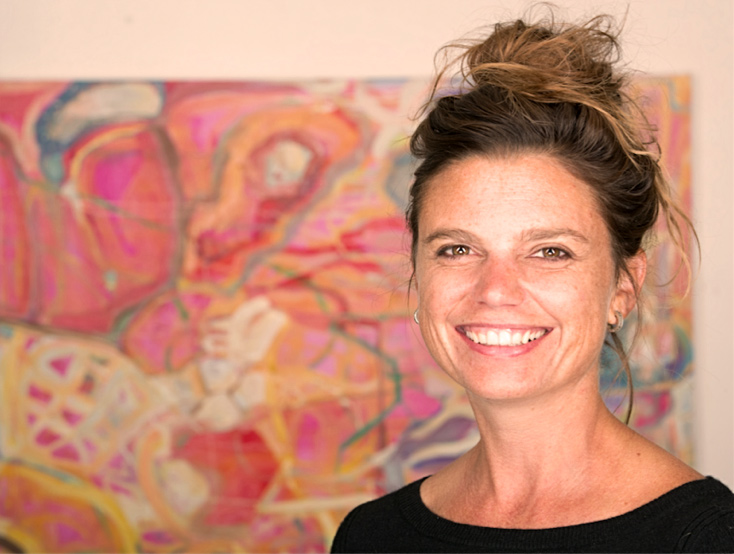
Lisa Daria Kennedy, photo by Joe Berkeley.
Lisa Daria Kennedy
“I’ve been making one small painting every single day for the last 3414 days.” After seven years, she has no intention of stopping. Having cancer as a young adult, Lisa discovered living is not just surviving. At age 29, she was a lead artist in the giftware industry when she was diagnosed with Non-Hodgkin’s Lymphoma. After six rounds of chemotherapy, one month of radiation, and now, years of monitoring to make sure she’s still cancer free, her perspective has changed. “Young and faced with an existential crisis, I questioned, who am I? What does it all mean? Psychologically, existentially, transcendentally – what can a life amount to? I was acutely aware of all the time I’d wasted and the things I put off – like painting.”
After all she had been through, the idea of starting an artistic project and failing was terrifying. She pared the creative process down to this one idea – show up for the job. “I treated creativity like a disembodied spirit and that I simply must be present daily to receive it. I started showing up for my new job in 2009 and without excuse, I wake up every day at five and I paint.”
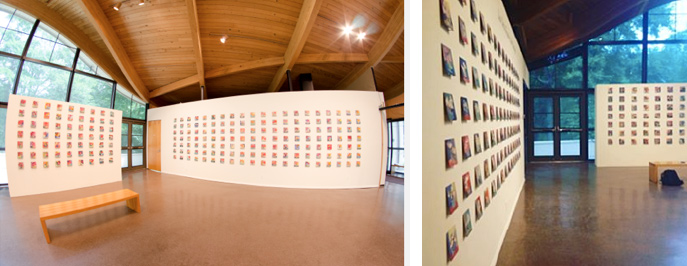
Lisa Daria Kennedy, Daily Painting Project, Art Complex Museum, Duxbury, MA
She was further influenced by a surge of online activity known as Daily Painting.
For the first time, a connection and community was present through blogging, a convenience not available even just ten years ago. The benefit of creating one small painting a day stems from the act of routine as practice. Painting every day is not a new idea. She quickly found a lineage of painters she had already admired, like Charles Hawthorne and Edwin Dickinson who created ‘premier coup’ or ‘at first crack’ paintings – small observational works created in one sitting.
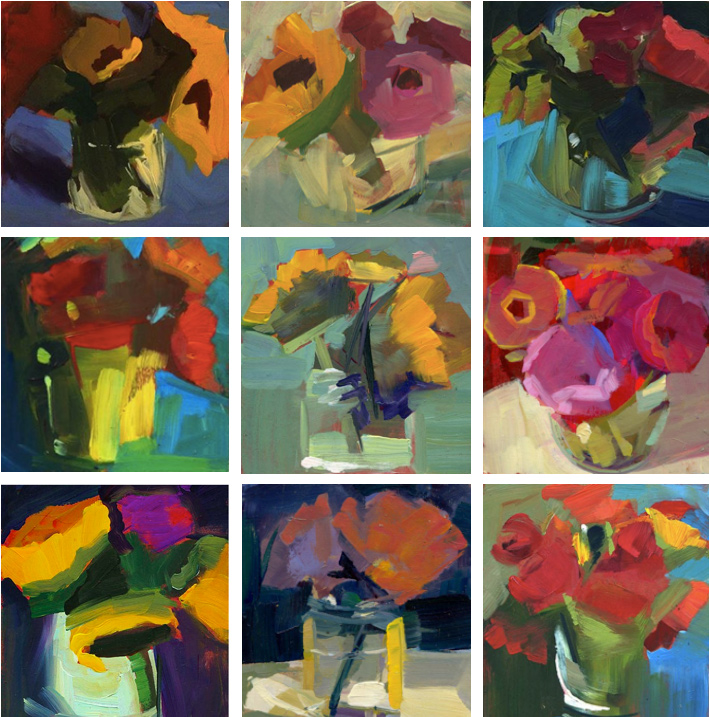
Lisa Daria Kennedy, A sampling of Daily Paintings, acrylic on unprimed masonite, 6” x 6” each.
“When I paint my pieces, I too, work primarily from direct observation. My technique is to make a mark and leave it – no fussing. I restrict myself to a limited color palette, six primaries consisting of three cools, three warms, plus pink and white. I use only two brushes and paint on the same type of surface each day – unprimed masonite. Each painting takes between one to three hours to complete. At the end of the day, I scan the painting, number and title it. Each title reflects something that happened during the day, like a journal entry. Finally, I post the piece to a blog and disperse it through social media to over 2000 followers, worldwide. For those who follow my blog, the paintings chronicle events in my life, yet the subject matter itself staves off the worry.
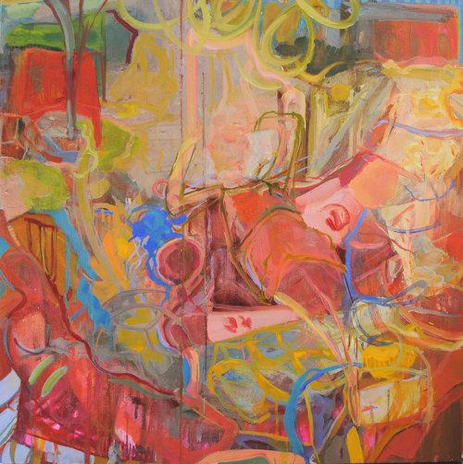
Lisa Daria Kennedy, Too Polite to Ask II, oil on canvas, 30” x 30”
She finds that routines are simultaneously freeing and grounding. Through daily practice comes inspiration, growth and confidence because this type of project is about process and not the finished product.
“In short, my philosophy is that you cannot have the good without the bad.” This daily practice allows a natural progression of skill and self-analysis while removing the anxiety of a final piece. The cumulative process is the end product.”
Daria-Kennedy’s ritual continues. Over the past two years she has expanded her work to move beyond the self-imposed, rule based project. In her Fainting Party series, women are shown in vulnerable poses. The edges of the figures break apart and there’s an uncertainty between where the interior body ends and the exterior space begins. “Cancer disintegrates a sense of stability and the potential for further catastrophe is incessant. So, there is a constant negotiation between one’s self and their surroundings.”
Lisa Daria Kennedy, Daily Painting blog: lisadariablogspot.com
Instagram: lisadariakennedyinstagram.com
Website: lisadariakennedy.com
Elizabeth Gilbert, “Your Elusive Creative Genius,” Ted.com video, 19:09, February, 2009.
Grace Glueck, “Haunting Moods of Edwin Dickinson,” The New York Times, November 11, 1983, accessed August 1, 2014,
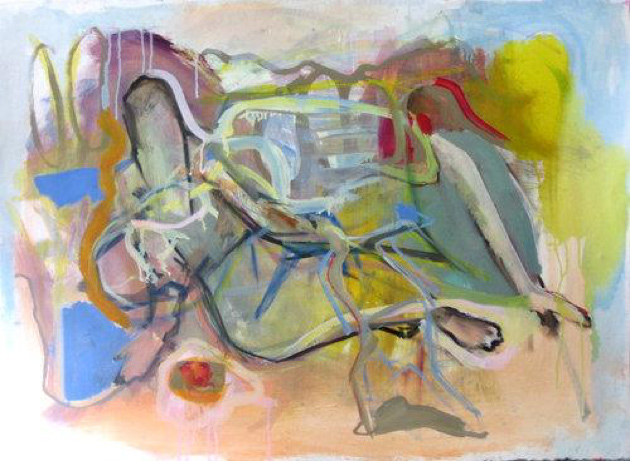
Lisa Daria Kennedy, Fainting Party IV, oil on canvas, 18” x 24”
NAWA SHOUT OUTS
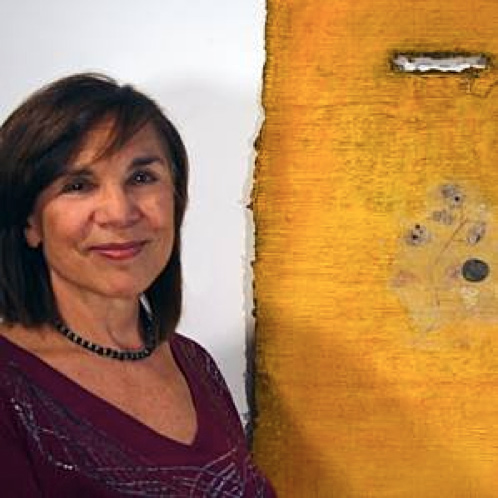
Joan Giordano
JOAN GIORDANO
NAWA celebrates Joan Giordano for her bold and beautiful visions, wishing her all success with her Catskills Art Society retrospective this fall in Livingston, NY from September 11 – October 27, 2018. Her mixed-media sculptures are a perfect match for this vibrant, newly expanded facility. This Manhattan and Upstate New York artist earned her MFA from Pratt Institute, where she studied with George McNeil. Working with Bob Blackburn at the Printmaking Workshop in NYC, her large-scale lithographs were freed from the picture plane to create unique sculptural shapes. In 1979 she co-founded ART-Lab at Snug Harbor Cultural Center on Staten Island, NY, which continues to thrive. Her core medium is primarily paper, but its use in her encaustic and sculpture works reveals a monolithic power. It has been said that paper can be called the marble of modern sculpture.
Joan Giordano has enjoyed more than a hundred museum and gallery exhibitions nationally and internationally, among them The National Museum of Art, Santiago, Chile, the Museo Del Corso in Florence, Italy, the First International Women Artists Biennial 2009 in Incheon, South Korea and the Athens School of Fine Arts, Athens, Greece, among others. In the U.S. she has exhibited at Fiberart International in Pittsburgh, PA, the Montclair, NJ Art Museum, and numerous solo shows, including the New Jersey State Museum, Trenton, NJ, American Museum of Papermaking, Atlanta, GA and others, such as the Tenri Cultural Institute, NYC. Her solo exhibit Steel Angels, and lecture series has traveled to several venues in Virginia, Texas and Georgia. She is represented by the June Kelly Gallery in NYC.
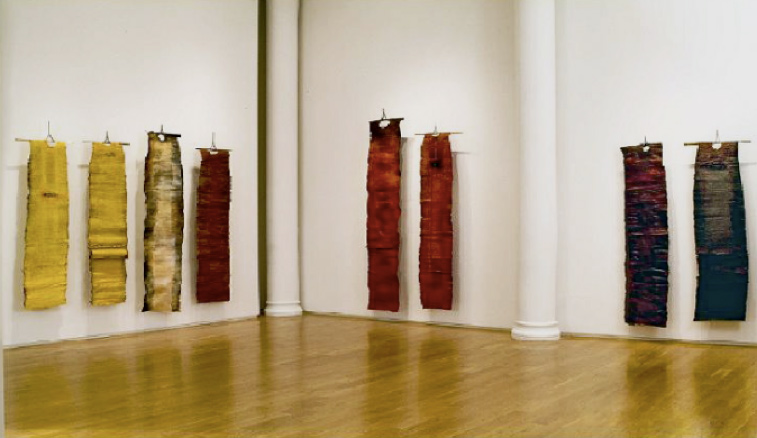
Joan Giordano, Presences, Solo Installation, 2007, Tenri Cultural Institute, handmade paper and encaustic.
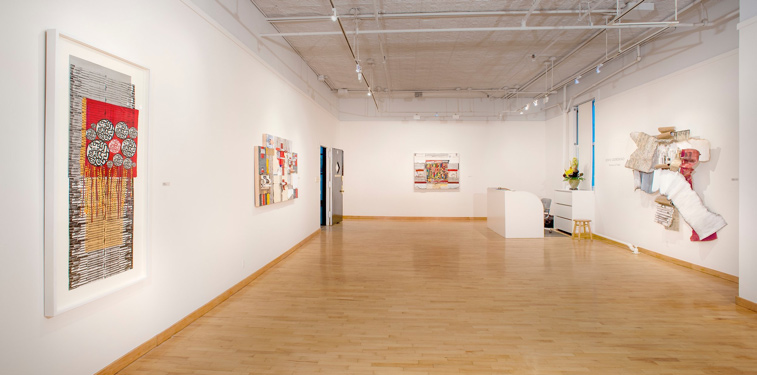
Joan Giordano, Woven in Time, Solo Exhibition, 2016, June Kelly Gallery, New York, NY.
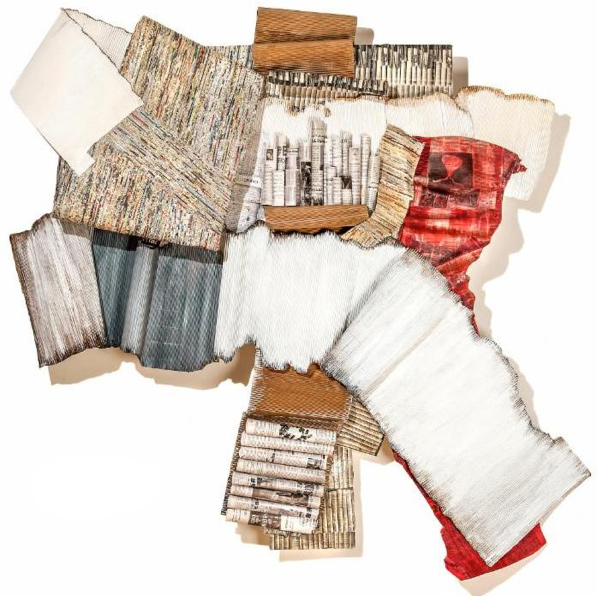
Joan Giordano, Epoch, 65 x 75 x 5 in, mixed media, handmade paper.
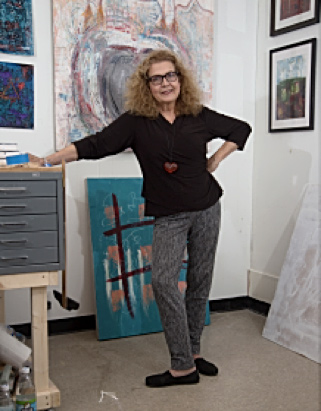
Nansi T. Lent in her studio.
NANSI T. LENT
Nansi T. Lent, current NAWA board member, has just opened Womenswork.art Gallery adjacent to her Poughkeepsie, NY studio, housed within Clinton Street Studios. An invitation to curate another local show of women’s work resulted in this exciting new endeavor. Her reason for womenswork.art is to showcase regional “under the radar” women artists. She feels Poughkeepsie is a unique place, with an exploding art scene driving social change.
Nansi is an innovative and ambitious artist, and we wish her success in this women-driven endeavor!
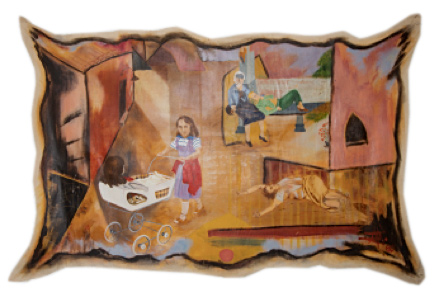
Nansi T. Lent, Walking the Baby, 1980.
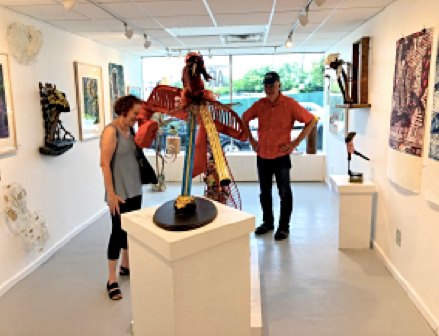
Installation view, Summer Punch exhibit.
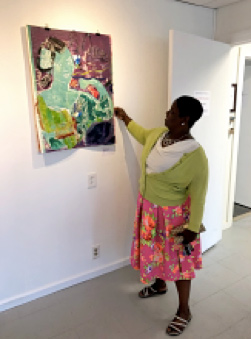
Visitor enjoying Penny Dell’s Billie.
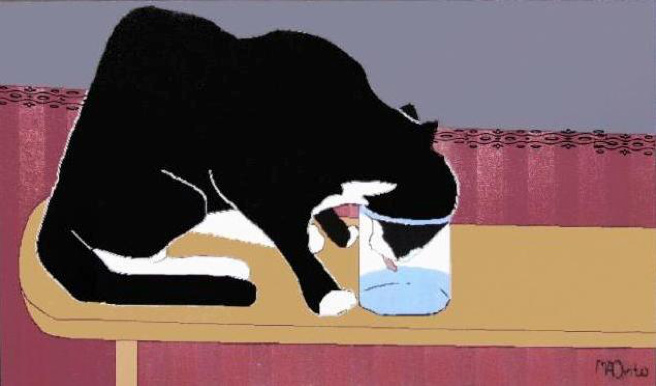
Mary Alice Orito, Mimi Drinking Water, signed giclee print of original collage, 8” x 12” matted.
MARY ALICE ORITO
Mary Alice Orito was a two-term NAWA president and served on the board for 8 years. Her love and commitment to animals will be represented in the My Menagerie exhibition of animal collage hosted by CauZ for PawZ Thrift Boutique at the Pop-up Gallery located at 333 First Avenue between 19th and 20th Street in Manhattan on November 12, 2018 from 4:00 – 8:00 pm. CauZ for PawZ’s unique New York Five Borough Feeding Program fosters pets and assists their owners who cannot afford to feed the animals under their care.
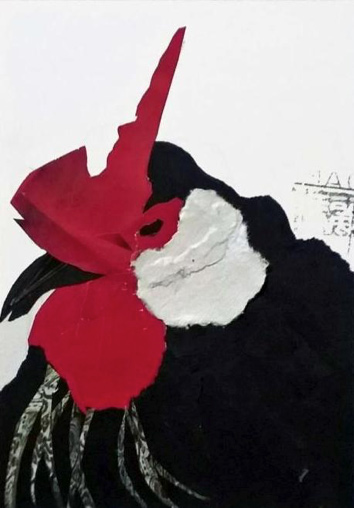
Mary Alice Orito, Black Rosecomb Bantam Cock,
signed giclee print of original collage, 8” x 12” matted.
In the early 1960s, she worked with Eva Hesse at Margaret Moore’s Jewelry Store in Greenwich Village for almost two years designing and selling jewelry. In talks about art and being an artist, Hesse imprinted in her mind the importance of lines and composition. “‘I was a country bumpkin from Kansas,’ she told us — incredibly lucky to have had so much personal time with her. She instilled discipline and attention to whatever I was doing in my art practice.”
After graduating from Parsons School of Design on Phillip Johnson Scholarships, Mary Alice had an extensive art and design career that included twenty four years as a sportswear designer, international design teacher, and a Local Union 829 Costume Designer for Broadway stage, music and TV. She shared an Emmy for costume design of Public TV’s production of Encyclopedia. She continued her education by getting an MSW in clinical social work. She has had a private psychotherapy practice since 1996 and an art practice since 1976. Her preferred media includes sculpture and mixed media/collage.
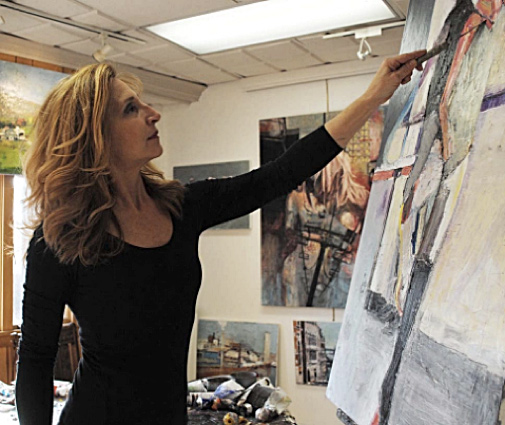
Joyce Werwie Perry in her studio.
JOYCE WERWIE PERRY
Emotion is the name of the game for Joyce Werwie Perry: “Art is all about emotion for me. Whatever the image I am painting, I have to go deep. Regardless of the subject… whether it’s images from the past, the beautiful topography of my city or a vivid abstract, my need to bring the human element to my work and draw an emotional response from the viewer is vital.” It’s been said that her paintings evoke that which is universal, yet personal. Her technique amplifies the emotion she strives for. “I strive to express emotion in my work through the rapid manipulation of paint. The application and detraction of oils with knives creates extreme textures and variations in color. There is always a tug of war between realistic and abstract elements, and this conflict usually results in the background breaking up or challenging the foreground.”
Perry is the owner of le Poire Fine Art Studio in Pittsburgh where she paints and teaches her unique knife technique to a school of oil painters. She was formerly on the teaching staff at Sweetwater Center for the Arts in Sewickley and holds workshops in various locations in the tristate area. Perry is a member of the Associated Artists of Pittsburgh and former vice president/exhibition chairwoman, and a lifelong resident of Pittsburgh.
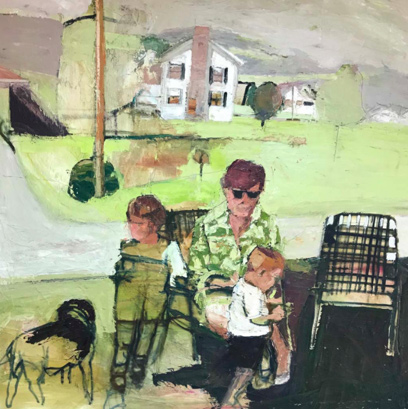
Joyce Werwie Perry
Suburbia III, oil on canvas
48” x 48”
juried into AAP 106th Annual Exhibition.
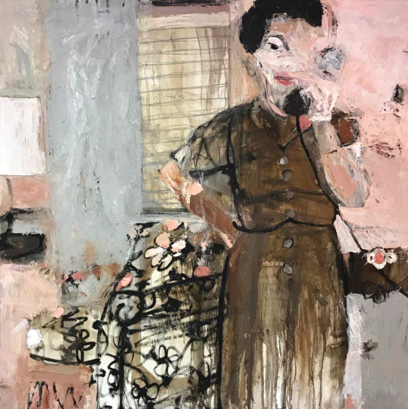
Joyce Werwie Perry
A Little Birdie Told Me
oil on canvas
48” x 48”
Catch Joyce Werwie Perry’s work at the following events and locations.
Associated Artists of Pittsburgh’s 106th Annual Exhibition
2708 Sidney Street, Pittsburgh, PA
September 14 – October 27, 2018
Galleries Representing Joyce Werwie Perry:
Firebox Art Studios
110 East Main Street, Carnegie, PA
Sewickley Gallery and Frame Shop
549 Beaver Street, Sewickley, PA
Camellia Art Inc.
One Office Way, Hilton Head, SC
Concept Art Gallery
1031 Braddock Avenue, Edgewood, PA
Le Poire Art Studio (her own studio)
11 East Crafton Avenue, Pittsburgh, PA
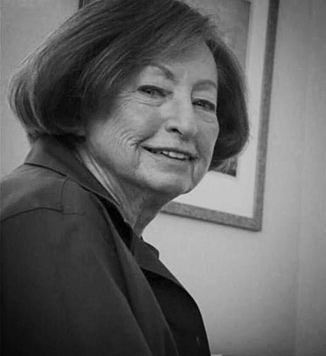
Rosyln Rose
ROSYLN ROSE
Roslyn Rose has on her website a wonderful quote from dancer Martha Graham, another intrepid artist with an unquenchable curiosity: “Artists have a blessed unrest that keeps us marching and makes us more alive than other people.”
That “unrest” has led this artist and her decades long love of printmaking and photography to turn her slides, photographs and found pictures into magical collages. She does this through her “virtual darkroom,” transforming her images on the computer into something uniquely her own. NAWA is happy to celebrate this artist member and her own brand of alchemy.
She has exhibited at the Hoboken Historical Museum, New Jersey, the Sommerville Art Museum, MA, the Ceres Gallery as well as the A.I.R. Gallery in New York City and elsewhere. Her works are in permanent collection at the Vorhees-Zimmerle Museum, Rutgers University, the Noyes Museum and others. The founder of the new Hob’art cooperative gallery in Hoboken, she is a long-standing member of NAWA and the International Society of Experimental Artists.
Roslyn is excited to announce the opening of her new studio, which recently moved into a new space at Sibley Square, 250 East Main Street, Rochester, NY. She is hosting an Open Studio event for the first time. The public is invited to a reception to celebrate the opening and to meet the artist who created the photographic montages that are on display.
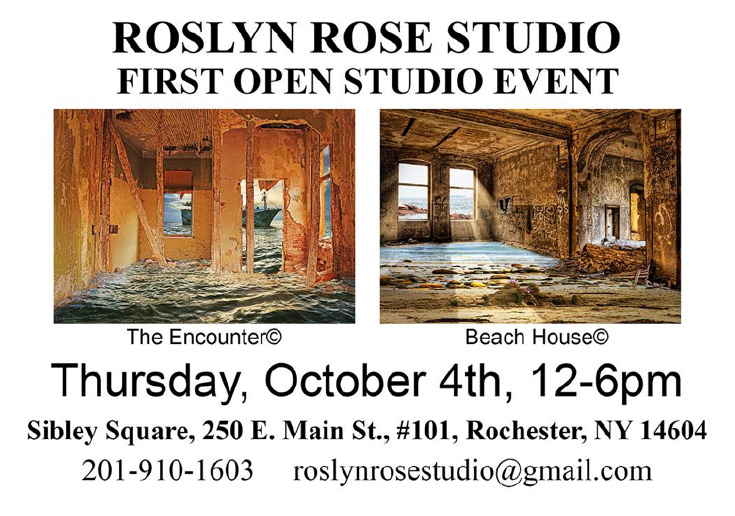
TOOLS OF THE TRADE
Organizing Yourself to Share Your Art
by Dawn Dahl
Through trial and error, I have created a system for myself that not only records and organizes my art but makes it relatively easy to enter group shows. I’ll describe that and touch briefly on promoting yourself. Please regard that as an introduction to the wonderful illustrations offered in the article that follows, “How Do You Promote Your Work?,” a virtual roundtable featuring five NAWA members who address this thorny topic.
Here’s what I do.
WHEN ART IS COMPLETED
Immediately Entitle Art – When I’ve worked Receiving for shows, I’ve been astounded at the number of artists who ask those at the desk what to call their piece as they are filling out entry forms. This process should take some thought: consider your inspiration, what your own finished art suggests to you, or even what you wish to communicate. It’s not always easy to come up with a good title, especially for an abstract. As a beginning artist, everything of mine was named “Still Life with…” and sometimes yet may be! (Yawn.) Adding some personality can work to your benefit; I can cite a few instances when a catchy title got art into an exhibition or even sold it. Keep that title short so that you don’t run afoul of show rules. And choose a name you can live with for a long time to maintain consistency throughout your system.
Photograph the Art – Maintain several sub-directories of art in your computer:
- One holds unedited original photographs
- One with a version edited to the most common specs (72 ppi/dpi for standard web resolution, no smaller than 1920 pixels on the longest side, 3.0 MB maximum)
- One with any artwork, sorted by venue, that you have had to re-size or label to a show’s specifications.
The goal is to make it easy to find and edit a photo so that you are ready to go and also keep a record.
Catalogue Specifics of the Artwork – I maintain detailed charts by year, with each piece of art listed as I begin work on it and all information in place when the work is completed. You’ll see examples of what I keep track of in the illustration below. That ranges from outlining talking points about the artwork, to its viability (sold/retired/destroyed/study of another’s work never to be exhibited). Note that color-coding makes it easy to see status at a glance.
Color Key:
Upcoming show
Dates committed
Exhibited
Award
Action Item/RETIRED
No longer mine
Original destroyed
Study of another artist’s work; never to be exhibited
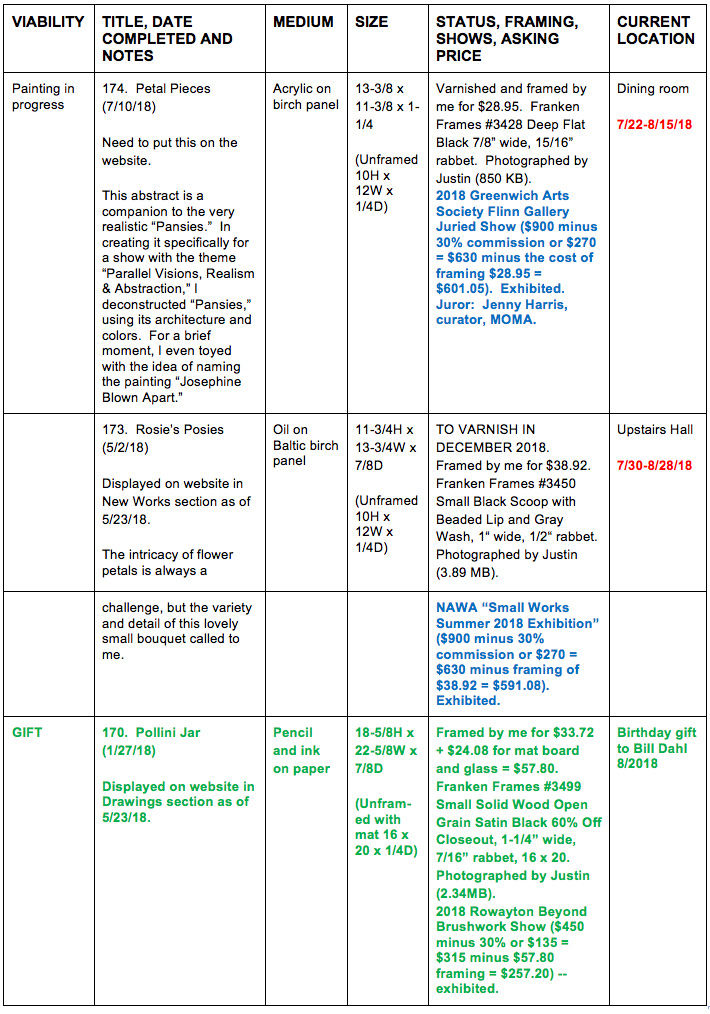
Stay On It – While I can attest that this effort definitely streamlines responding to an opportunity, the system will fall apart if you don’t diligently update information.
WHERE TO SHOW
Check Your Friends and Online Sources – Other artists introduced me to many exhibitions and to online show listers such as onlinejuriedshows.com, artcall.org, callforentry.org, entrythingy.com, showsubmit.com, and smarterentry.com that occasionally unearth something completely new. I began locally at the town library’s summer show and then branched out to area artists’ guilds and associations, becoming a member of several in the process. Now I add in whatever national opportunities meet my strictures.
Continually Review Opportunities – You will want to balance what to enter and when, considering your goals and what is most important to you. That means regularly assessing criteria and involvement by both considering the experience of each show (Is it worth the effort?) and conscientiously seeking new venues.
PREPARING TO PROMOTE ART AND THE ARTIST
Craft Talking Points – To avoid being caught flat-footed in speaking to anyone about my work, I distill what I want to communicate about a painting or its creative process and enter that in my chart. This also helps with any “essays” required in application to a show.
Keep “Materials” Ready – Carry a business card with your website address on it to share with anyone who asks about your art. Maintain a current bio in a readily accessible online file. You may have to tailor it to specific needs, but at least you’ll have most of it written already. And please update your website regularly. If you don’t have one, you’re missing an easy way to promote yourself (and one that some shows expect you to reference).
Plan to Promote Yourself – After a 33-year career in public relations, I will attest that promoting yourself takes self-awareness, thought and time. Some PR essentials, in no particular order:
- Define Your Goals – Decide what you want before you proceed. My motivations are painting for the pleasure of the process and showing for validation (with maybe a sale to make space in my studio). Contrast that with the very different goals of an artist whose ambition is to become self-sustaining or one who has a communications mission.
- Research and Gather Information – Make a habit of learning everything that you can about your market. Read broadly, stay abreast of developments in the field, check out any leads, look for inspiration, and ponder why what you observe may be happening. You must ground any public relations activity in reality.
- Formulate a Marketing Plan – Standard business practice is to create a plan of specific, targeted activity tied to your goals. This is important to keep you focused, but don’t get hung up on the formality of it. Regard it as an on-point, well-considered but flexible to-do list that should change over time.
- Differentiate Yourself – You have to separate yourself from the pack while keeping what matters most to you firmly in mind. What distinguishes you becomes your “brand.” Now brainstorm ways that you might “sell it.” List everything you can think of to draw attention to your art, and then be prepared to come up with your own twist. For example, realize that a press release is simply a vehicle, and, all too often, a tired old clunker at that. How can you make it an arresting and attention-getting fire engine instead? Aligning fresh positioning and new approaches with what is true to your brand will most effectively deliver your message.
- Get Yourself Out There and Capture Those Contacts – Above all, be a presence! While it sounds daunting to build a “network,” all that really means is that you maximize every opportunity for contact that you have however useless it may seem at first glance. Attend events, take courses, join organizations, talk to anyone who might have information that can help you better market yourself. Think of every person who responds positively to your art as a candidate for your mailing list, and don’t be shy about asking for their contact information.
- Consider Your Targets – Start with analysis. Your targets are the people you want to write about you and your art, to talk about it or to attend to it. What will they be likely to respond to receiving from you? Always keep your audience in mind. If you understand their needs, it will be that much easier to find an appealing angle that the target can relate to—an arresting illustration, an interesting story or something else that will compel that person to communicate about you.
Put Out the Word – Ways to reach your network include posting, blogging and mailing, whether in the form of a newsletter or alerts about your doings. Make yourself known in your town. Any media should be aware of you as a resource, and with a good hook, they could feature anything you have happening locally. That’s news.
Please read the roundtable article for other examples, especially in dealing with the Internet. I was so impressed by the ability of these women to teach themselves about public relations, to recognize their strengths and weaknesses, and to find resources. I think that you will be too. The experience they describe can help you better promote yourself and your art.
HOW DO YOU PROMOTE YOUR WORK?
A Virtual Roundtable, Moderated by Dawn Dahl
Participants:

Judith Carlin

Marie Hines Cowan

Susan Hammond

Judith Modrak

Mary Alice Orito
Judith Carlin, an artist who explores the human condition through painting.
Marie Hines Cowan, a figurative oil painter who marries mythology with colloquial culture, and a former president of NAWA.
Susan Hammond, contemporary photographer, executive director of NAWA and a past president.
Judith Modrak, a New York-based figurative sculptor and installation artist who explores interior landscapes from psychological and neurological perspectives.
Mary Alice Orito, visual artist and psychotherapist, and a past president of NAWA
One of the great challenges for most artists is in promoting one’s own work. What do you consider to be essential to creating attention for your art?
Judith Modrak: To start, create work you are passionate about and that matters to you. This needs to be central to your practice so that you feel strongly about it and are connected to it. It is first and foremost a matter of “engagement.” Think about the kind of work you do. You must understand where you fit to be able to target those who share that interest, whether that means individuals, specific groups, publications, galleries, etc. In that way, you will reach audiences that have the potential to be receptive.
Susan Hammond: I have learned everything by connecting socially through the various organizations I joined and from interfacing with others when taking classes. That face-to-face interaction, personal one-on-ones, reaps a ton of information. You get more when you meet people, which argues for volunteering within an organization or working on a local project. Most people are very generous with information; I try to respond in kind. I think we all need that. Being an artist can be very lonely. So it’s good to force yourself to get out and socialize.
Marie Hines Cowan: You have to get yourself out into the public eye, and there’s no one right way to do that. We’re not talking about just communicating with friends or NAWA, but reaching the general public. And nothing happens in a vacuum! Apart from my Tuesday-Wednesday office job, I try to have organized “business hours” for my art. That means Monday and Friday are my days to create it. I don’t wait for inspiration, I “go to work,” meaning that I go to my studio just as I would approach a job, without distractions, and put in full days. Ninety-nine percent of success is showing up. Thursday is dedicated to all of those “paperwork things,” including promoting myself. Even though I have a team to help, I still spend that much time on it, and it’s working.
Mary Alice Orito: If you want to promote yourself, you have to focus. People only want to know a style. Anyone representing you is going to say they need to have enough inventory to be able to sell it. That was hard to learn. Many women will create artwork inspired by impulse alone, and that’s fine if it’s what you want to do. But if you wish to succeed, you’ve got to be disciplined about how you spend your time. This could be viewed as a constraint, so I work in more than one medium, which allows me to explore different directions.
Judith Modrak: It’s probably better not to think of a grand endpoint, such as “being profiled in The New York Times.” That’s a daunting mountain to climb. Instead, welcome all opportunities for engagement, regarding them as steps toward your goal, something to enjoy rather than an onerous task. And tailor everything that you do to your own use. This is your plan for you. Remember that you are your brand; the marketing strategy you formulate should create a distinctly identifiable perception of you and your work with all elements reinforcing that. Consistent actions that align with your vision will speak to who you are as an artist. And if you are not getting the results you want, try something different while embracing your authentic voice.
Judith Carlin: You need to consider what you are communicating through your art so that you can tailor your list of contacts accordingly. Because my work focuses on social problems, I look to get it to people, judges and organizations that are interested in those subjects, and I do that by researching everything online and by participating in social media. I rely on Facebook, Instagram and blogging through my website. I’m no longer on Pinterest because I found it to be not really business-like. And I don’t use Twitter because I feel it’s geared more to conversation than visuals.
Here we are, already discussing the role of the Internet…
Susan Hammond: What is essential to promotion these days is a presence on social media – that’s everything. Every artist should have a website; other basics are Facebook, Instagram and LinkedIn.
Judith Carlin: I agree; a website is essential for an artist. It serves as the source of broader information about you and your work. More than once, the initial art that led potential shows and collectors to my website was not exactly what they wanted, but then they fell in love with something else they saw there.
Marie Hines Cowan: I really do not love the Internet. I’m not comfortable on it. So I found someone who does social media, and that has made all the difference for me. What’s important is that you get help because time, interest and ability can be a stumbling block. Whatever you do in terms of enlisting others doesn’t have to be hugely ambitious – maybe it’s enough for you to consult with your nephew who knows Instagram. You should pick and choose what you do, and have others handle what you loathe.
How comfortable and skilled are you in promoting yourself?
Judith Carlin: I didn’t have anyone to teach me how to promote myself in this way. It arose from my own discomfort with face-to-face interaction. It would be hard for me to drop into a gallery in person to pitch my work, but I feel comfortable going online with a hashtag. That’s because it is more impersonal. You have time to shape what you say, you are able to research your contact, and you can even ignore or block that person if necessary.
Mary Alice Orito: The biggest problem that we as women artists have in promoting ourselves is that we have been socialized not to brag, which makes us timid. We have to overcome that if we want to see our representation in the art world change. I think that the average presence of women’s art in museums hovers around 13 percent, which hasn’t changed much in my lifetime. (It was 10 percent in the 1970s!)
Susan Hammond: When I first meet artists, I like to ask them about their work, to see what they say. You’d be surprised at how many are shy when they need to think of this as an opportunity to shine. I’ve found that you have to take a gamble. Being timid won’t do. We all recognize that squeaky wheels get attention – and some aren’t the best artists!
Judith Modrak: In an artist’s early days, wide exposure is key. Your public library, community arts center or a nearby university may provide great opportunities for exposure. Non-profit organizations are also a wonderful entry point for marketing yourself and making connections. Invest energy in creating compelling proposals for different forums. Art needs to be in the world; figure out ways to get it out there. And don’t think of this as a problem or something to dread doing. Remember that you are promoting what you love to do.
Marie Hines Cowan: I live by the Nike motto, “Just do it.” You can’t be afraid. All that activity builds the “network” everyone always talks about. Sometimes it’s simply a matter of keeping your feet in the pool for however long. Lately a rash of journals interested in art and literature have approached me about my art, which I describe as mythology/literature/history-related. They were through contacts of many years standing.
What steps do you consciously take to publicize your own artwork?
Susan Hammond: Once you are accepted into a show, the press release and invitation should be sent to everyone you know. I don’t just mean friends and family – you have to get beyond that; it gets old for them. You should have a mailing list with the names of all of your contacts—those who have purchased your art, teachers and other students, people you’ve met, and anyone who has shown an interest in your art.
Mary Alice Orito: Today, I am mailing what I call “my F/U-P-P (update packets to patrons of my art).” I send out updates twice a year to all people who own my art work.
Marie Hines Cowan: My newsletter mailing list is about 25 percent from exhibitions over the years, 25 percent what I have culled from Graphic Artists Guild Handbook (which lists galleries, publishing houses, and others who are interested in art), and 50 percent a list that I have purchased from Caroll Michels in Sarasota, Florida, of people in the art world. My social media person, Cristiana Pena of Pena and Porter in New York, whom I found by word-of-mouth, is on retainer; we have a basic strategic plan and meet every month to assess activity. I’d willingly recommend her. They’ve fixed up my website; now I’m on Instagram, have a page on Facebook, send out press releases, and they help me produce that regular newsletter that goes to 700 to 900 people.
Judith Carlin: There’s no doubt that promoting yourself can be time-consuming, but I consider it an ongoing process. My list is always developing because everything that I do feeds it. What appears online can lead to solicitations by organizations and galleries to participate in shows. And I love hashtags. Magazine editors follow them. That’s a way that they have reached out to me. You certainly can use hashtags to develop a contact list. For example, someone who paints landscapes or abstracts might want to hashtag home and garden magazines.
Judith Modrak: I believe that promoting one’s art doesn’t mean sticking to a fixed and rigid set of “do”s and “don’t”s. That won’t get you very far! Promotion should be considered a work in progress – constantly evolving and changing. It’s a growing, organic activity that requires you to ask yourself tough questions and be totally honest about what is or isn’t working so that you are able to shift strategy. You may have to change your mindset to find the right path. (And it’s true that you learn from failures.)
Please give me an example of an experience you yourself had that you considered to be particularly successful. Did you do something specific or special that made it work? Is there a lesson that others could take from that?
Marie Hines Cowan: I keep showing up on the Internet, generating a lot of little things because I believe that one pebble rolling down the hill can hit another. The small show you regard as minor, or getting a drawing on Instagram, can turn out to be important – you never know where it can lead. An example: When a group in London discovered my work online and invited me to participate in an art fair, I was reluctant. But leaping into that resulted in a surprising relationship with a British curator.
Judith Modrak: My best investment has been in what I call “resources.” A real game-changer for me came in the form of a five-day boot camp led by Creative Capital and the Lower Manhattan Cultural Council that provided a model of sustainability as an artist. My “re-set” was not just to create art, but to pursue a sustainable art practice while initially juggling other revenue streams. “Resources” could include hiring a studio assistant, or a photographer, or someone to teach you to become fluent in Photoshop – whatever you need help with to function better. I’ve gained a lot from attending workshops, whether online or in-person. Those include some offered by art coaches Gigi Rosenberg based in Oregon and Paul Klein in Chicago, who conduct workshops online via Webinars as well as consulting privately. They can help you tailor your art message and give insight into how you fit in the larger art world, teach you how to write a grant proposal, or even suggest how to delegate to concentrate on what’s most important to you.
Mary Alice Orito: Reading online is the number one thing to do, to subscribe to many services to find out what’s current in the art world. If you want to make a statement through your art, especially politically, you’ve got to keep up, to stay relevant. In this respect, galleries are glacial. They are becoming peripheral to what’s happening, and many people don’t even visit them anymore A resource that can inform what you next create are the different sites for art show listings, such as www.onlinejuriedshows.com and www.showsubmit.com. Surveying the themes for upcoming shows can give you a read of what’s going on, even six months out.
Judith Carlin: We’ve talked a lot about the Internet, but haven’t raised another benefit of promoting yourself online. The Internet provides some distance, allowing the person contacting you to take ownership. She believes she found you and that she is the one making the “yes” move, rather than reacting to a solicitation, which by its very nature a defensive, unreceptive position. This really does work! A gallerist who thought she had discovered me in just this way actually ran to the door to hug me when we finally met face-to-face.
Susan Hammond: Here’s my personal example of some self-promotion. When I was ready to retire after years of working as an illustrator for the Department of Defense, I was also ending my years as the president of NAWA. I knew the organization needed an executive director, so I wrote a job description and then presented it to the board. But I guess you really could call that a career move, since the job became mine.
You must know so many artists through NAWA. From what you observe, what would you say are some basic rules you wish more would follow to get themselves out there?
Susan Hammond: You have to be free with information about yourself in a friendly, nice way, even under difficult circumstances. I once overheard two gallery visitors discussing a sculpture they said they didn’t understand, typifying it “garbage.” The artist, standing nearby, was crushed. I insisted that she talk to them, to explain her work. When she screwed up her courage and did just that, it went very well – and she educated some viewers who knew very little about art.
Marie Hines Cowan: There’s a NAWA member who puts out a bold, colorful newsletter of her artwork, which is of graphic aerial images. I really admire that because she’s selling herself in an arresting way. Nothing is sadder to me than the meek invitations I so often get that say, “Hi, everyone, I have an exhibit coming up and I hope you’ll attend,” all in lowercase. Why bother? Where’s the hook, the image that will interest anyone?
Judith Modrak: It’s important to represent your art in the most compelling way possible. I’ve been on juries where art was eliminated from consideration simply because the packaging was not well done or directions were not followed. Artists should invest in quality to present themselves in a favorable light. That may mean finding someone to spellcheck you or hiring a good photographer to produce great representations of your art if you can’t. (If cost is a concern, schools may have willing students or interns who need the experience.)
What about any cautions?
Susan Hammond: While you do need to be aggressive in promoting yourself, don’t be rude. Handing out your business card at someone else’s show or snagging visitors at a gallery door to direct them to your art may help you become better known – but in a very negative way. You certainly won’t be making friends.
Mary Alice Orito: We’re fighting an endless social conundrum: We can’t afford competition because there are so few opportunities, yet we should boost each other. There is nothing to be gained – except perhaps fleeting ego gratification – by putting another woman or her art down. It’s just not helpful. Mentoring is a relatively new idea. We still are having to devote our lives to trying to improve the acceptance of women in art.
Judith Modrak: I would caution about pay-to-play situations, which are tricky to navigate and can be viewed negatively. The traditional vanity gallery doesn’t have credibility, and you probably won’t be reviewed. Whatever opportunity presents itself, research it well before committing, and if it doesn’t feel right, trust your instincts. I do believe that do-it-yourself (DIY) art fairs are different. I loved participating in the Governors Island Art Fair for its focus on experimentation and the opportunity to connect with other artists. The exposure and visitor traffic were off the charts.
Judith Carlin: The flip side of an environment as impersonal as the Internet is that there is always the need to be careful. Google any contacts to check them out. Do whatever research you can to assess an opportunity, and above all, if you meet, choose a public place. We all know there are a lot of scammers and crazy people out there.
Judith Modrak: You should analyze and assess any opportunities so that you are using your time wisely. That is to say, time spent should be commensurate with the value of the activity. Obviously, you would not expend as much energy on a group show as on your own solo exhibition!
Who would you say taught you how to market yourself and your art? Or that you perhaps chose to emulate?
Susan Hammond: I credit my mother and grandmother with teaching me to market myself. They always said that I could be whatever I wanted to be if I just applied myself. But I also learned from mentors like Joyce Tenneson and Mary Ellen Mark.
Mary Alice Orito: Early on, I worked with Eva Hesse, a great influence on me who would talk to me about her art. She gave me a rule, “Do not do anything that is feminine in art,” and I have fought that dictum ever since. It doesn’t seem right that we should be labeled or corralled into limited space. Men really have a leg up. I want to have that same freedom as an artist.
Marie Hines Cowan: I have learned a lot by working with Gigi Rosenberg and Renee Phillips and also by reading a lot about promotion. Some books include:
- How to Survive and Prosper as an Artist: Selling Yourself Without Selling Your Soul by Caroll Michels
- I’d Rather Be in the Studio: The Artist’s No-Excuse Guide to Self-Promotion by Alyson Stanfield
- Success Now! For Artists: A Motivational Guide for the Artrepreneur by Renee Phillips
- The Artist’s Guide to Grant Writing: How to Find Funds and Write Foolproof Proposals for the Visual, Literary and Performance Artist by Gigi Rosenberg, who is the editor of Professional Artist magazine, which also is a great source for information.
Judith Modrak: No one specifically taught me how to promote myself, though I have researched other artists that I admire. You can go back in their history to see what they have done to use that as a guide. What’s important is that you constantly keep learning, reading everything you can. Books and art advisories online are a great resource; I recommend anything written by the people and organizations I’ve mentioned. I once was told to “follow the light.” If someone responds positively to your work, look for like people and outlets. Don’t allow negative responses to define you as an artist. Because you got a “no” once doesn’t mean it will happen the next time. Everything is always changing! A revelation to me was that there is not one thing – a collector, an article, an event, a show – that is a tipping point. So don’t put artificial pressure on yourself. Part of the evolution of promoting yourself is that your greater presence and clarity of vision will eventually draw people and opportunities to you.
Great advice! Thank you all.
To see more of these artists’ work:
Visit www.judithcarlin.com and connect with @judith_carlin on Instagram and Judith Carlin (www.facebook.com/judith.carlin.9) on Facebook.
Find Marie Hines Cowan at www.mariehinescowan.com.
Visit www.judithmodrak.com and connect @judithmodrak on Instagram and Facebook.
Mary Alice Orito’s website is www.maoartnyc.com.
ARTIST MUSINGS
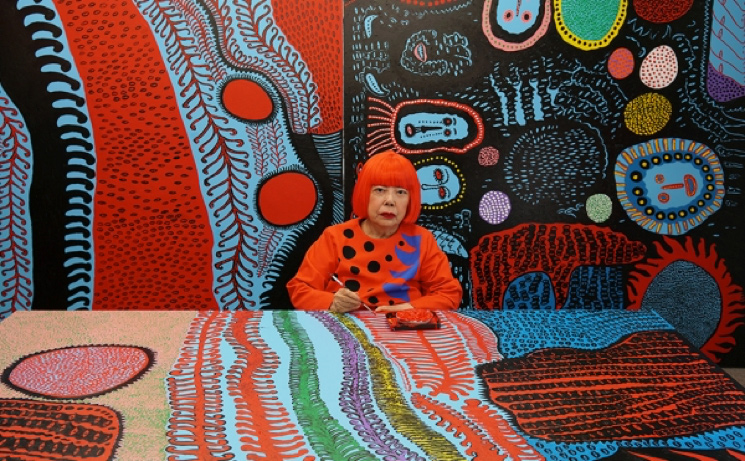
Portrait of Yayoi Kusama in her studio (image © Yayoi Kusama, courtesy of David Zwirner, New York; Ota Fine Arts, Tokyo/Singapore/Shanghai; Victoria Miro, London; YAYOI KUSAMA Inc.)
Yoyoi Kusama
Visiting the Museum of Modern Art in New York, in the late 60s, Japanese artist Yayoi Kusama is well-known for having asked, “What is modern here? I don’t see it.”
Heather Lenz’s recent documentary, Kusama-Infinity explores Yayoi Kusama’s life, art, and her incessant struggle to be seen, to be respected, and to be given her due. Born March 22, 1929, this now legendary Japanese conceptual artist redefined “modern” for such male trendsetters as Mark Rothko and Andy Warhol and many others whether they liked to admit it or not. Taking Georgia O’Keeffe’s advice, she moved from Matsumoto, Japan in 1955 to New York, burning 2,000 of her drawings. Crashing the 1966 Venice Biennale, she covered the Italian Pavilion with reflective spheres made of plastic. When she began selling her spheres to passersby for $2, she was quickly forced to leave the premises. Always one to question convention, she rebutted, “Why can’t I sell my art like ice creams or hot dogs?”
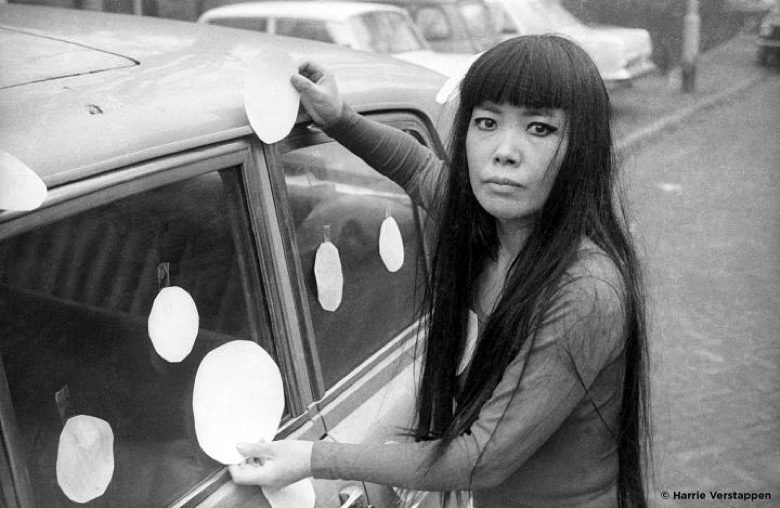
Yayoi Kusama next to her “Dot Car” (1965), from Kusama-Infinity, (photo by Harrie Verstappen, courtesy Magnolia Pictures)
Kusama persisted through the decades so well, in spite of the predictable pushback from a male-centered art establishment, that when her Infinity Mirrors was exhibited at the Hirshhorn Museum and Sculpture Gardens in Washington, D.C. in 2017, it attracted 160,000 visitors to the site.
(Kusama Infinity was released nationwide on September 7. It is screening at Film Forum (209 West Houston Street, West Village, Manhattan) and the Nuart Theatre (11272 Santa Monica Boulevard, Los Angeles). Look for this film at your own city art houses, but more importantly, familiarize yourself with this remarkable artist.)
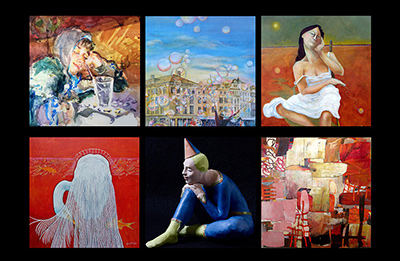 DAYDREAMING
DAYDREAMING
NAWA NATIONAL & NAWA FLORIDA CHAPTER
CORAL SPRINGS MUSEUM OF ART
2855 Coral Springs Drive
Coral Springs, FL
September 22 – November 17, 2018
Artists listed clockwise: (Top left) Georgieva Antoaneta, Marilyn Liedman, Cassandra Gordon-Harris, Patricia Zalisco, Heather Blume, Roberta Millman-Ide.
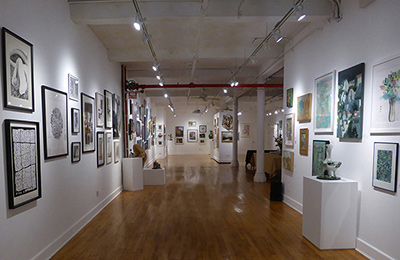 129th ANNUAL MEMBER’S EXHIBITION
129th ANNUAL MEMBER’S EXHIBITION
195 Chrystie Street Gallery
195 Chrystie Street, NYC
Member Prospectus
October 6–18, 2018
Reception: October 11, 6-9pm
ART ANGELS
Volunteer Exhibition
NAWA GALLERY
315 West 39th Street, Suite 508, NYC
October 10 – 31, 2018
Reception: Thursday, October 18, 2018 6-9pm
Member Volunteer Guide
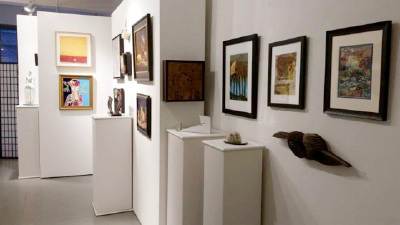
New Members’ Exhibition, 2017, NAWA Gallery.
NEW MEMBERS’ EXHIBITION
NAWA GALLERY
315 West 39th Street, Suite 508, NYC
November 1 –29, 2018
Reception: Thursday, November 15, 2018
TRANSPARENCY
ARTS CLUB OF WASHINGTON
2017 I Street, NW, Washington DC
February 1 –23, 2019
Reception: Friday, February 1, 2019, 6:30-8:30pm
Deadline to submit: Monday, December 10. 2018
ART AND AWAY
Travel is a loaded subject. But one thing’s certain. No matter whether you travel as far as Machu Picchu in Peru or a few steps into your backyard, it can change you. The memories that you bring back with you are irreplaceable. Locked in your camera or iPhone or scribbled in your journal, these memories will be reawakened upon your return. They will haunt your hours, enter your pores and burrow into your dreams. And if you’re lucky, and persistent, they will emerge transformed through your art.
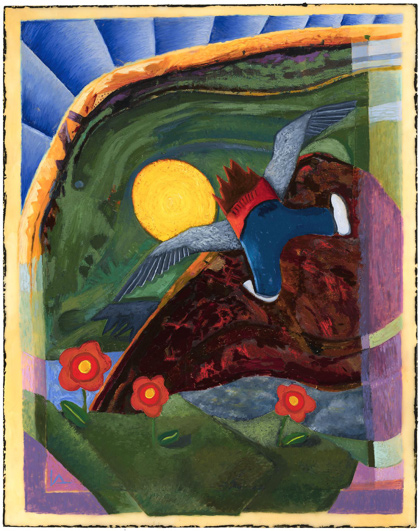
Lucinda Abra, Higher Ground, encaustic, oil and collage on wood.
LUCINDA ABRA
Unlike our digital devices, we can’t just plug in for a charge when we feel depleted. What we can do is take a vacation, giving ourselves a necessary jump-start. By stepping away from the day-to-day, our visual language expands in so many unanticipated ways, paying artistic dividends. We come back to the studio filled with new ideas and inspirations that occurred seemingly out of thin air. The fire in the belly burns brighter. While there is no place like home, walking through the uncommon brings the artist new material to expand upon.
Whether the car was packed with sketching materials or watercolors, you journaled your way through the itinerary on your phone and captured photographs to be expounded upon at a later date. Inspired seeds were planted, pulled from these alternative experiences.
Artists take vacations bringing their fertile imagination with them. There is a cornucopia of productive stimulation beyond the studio door. Alchemy is always in play in the creative life. Enjoy the magic, and join me in planning your next get-away. Having grazed on the unexpected, our creativity will be fed well.
KIM ALEMIAN
The sound and smell of a new place is scintillating. Traveling the world is one of the most enlightening inspirations for me, taking me out of my element and opening my raw senses to new explorations. I tend to assign colors to a place based on what I see before me.
Stepping off the train in Venice, surrounded by water and lively, colorful activity, and breathing in the lagoon air of the cobalt green waters was my first introduction to this ancient city. Footsteps clattering across the bridges conjure textural images in my mind. Rich ultramarine blues are speckled about in the clock towers in Piazza San Marco and the venetian red brick of the Campanile punctuates the space with its warmth. Lake Como is Cobalt Turquoise, violet pastels and a range of ochre, terracotta and blue/green mountains.
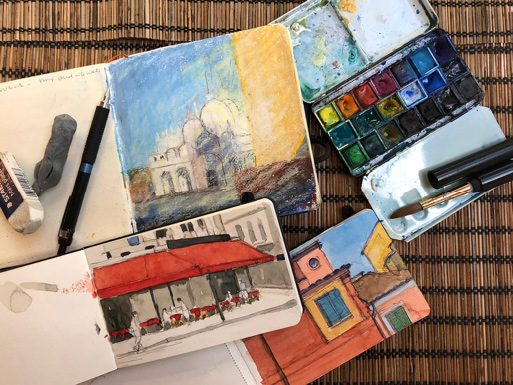
Traveling sketchbook and art supplies.
Lavender fields in Provence, the fragrant flower-scented scenes with lush greens and little buildings of light yellow ochre and Blue-Lavender shutters and doors create a whole color scheme. In Roussillon, the Vaucluse Provence-Alpes-Côte d’Azur region, lies the vivid ochre pigment quarry. The color is so strong it feels like warmth and light emanate from the ground. Here is where the ochre pigments were once mined.
The intensely bright light of the Côte d’Azur and its clear turquoise water and saturated orange rooftops recall the paintings Bonnard and Matisse did here and I see and know the colors they infused into their work.
Warsaw is brick, cadmium yellow, tinted phalo green and decorative thin black wrought iron lamp posts that look like lace against the sky. The paintings of Bernardo Bellotto, Canaletto’s nephew come to mind. His detailed paintings were largely relied upon to recreate the city when it was destroyed in World War II.
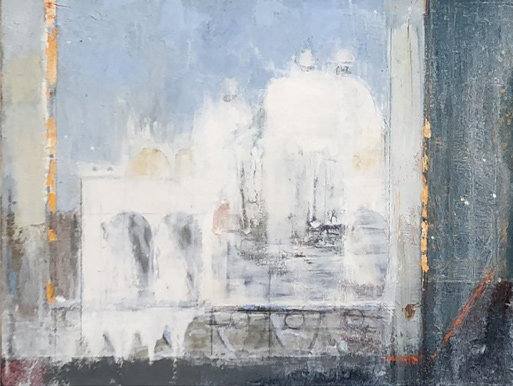
Kim Alemian, Piazza St. Marco, Venice, oil & mixed media on linen.
Paris is vibrant Cadmium Red.
I always bring a small watercolor notebook, a set of watercolors, a good sable travel brush, a few oil pastels, a technical pencil, white and kneaded erasers. These tools are inconspicuous enough to pull out at a cafe table, bench or curbside. The ideas and patterns find their way into my work when I am back in the studio. When I record a place by drawing it, it tends to stay with me in a concrete way. Looking back at these sketches is like time travel, the memory of place is as clear as being there.
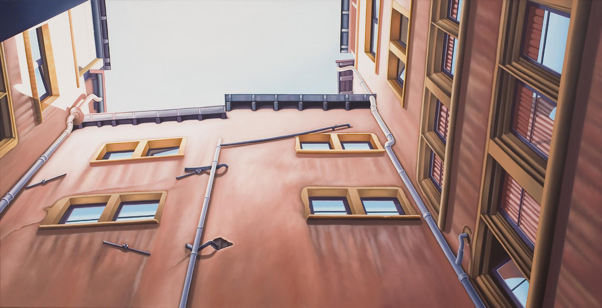
Pennie Brantley, Vertiginous Aspirations, oil on canvas, 36” x 72”
PENNIE BRANTLEY
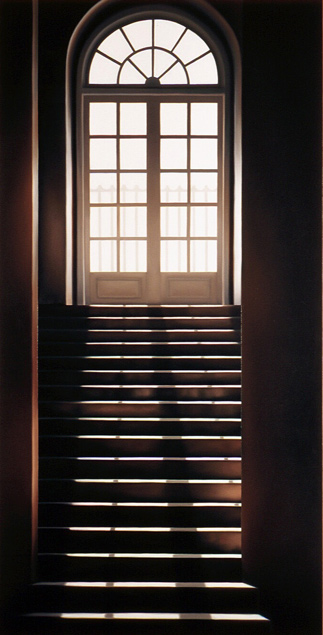
Pennie Brantley, Intent, oil on canvas, 72 x 36”
Unforeseen happenstance provided my first opportunity to travel abroad. Blissfully unconcerned about my shoestring budget, I was enchanted. I hungered for more explorations, to see the myriad ways in which people shape their cultures, lives and physical environments. Simply breathing in the heady air of foreign lands was exhilarating – and still is!
Although I knew I was an artist at a very young age, eventually there was a definitive point at which I felt compelled to use images from my increasing travels. Without my conscious decision, they initially presented me with a covert way to portray difficulties I was dealing with in my life. This was simultaneous with my desire to share the wonder of the astonishing accomplishments of humankind. While seemingly precise representations of physical places, I consider them to be communication with the subconscious, presenting universalities of the human condition that transcend geographical territories.
My usually large oil paintings are done in my studio at home. Too busy exploring while we (my artist husband and I) are traveling, it is impossible to stay in a place abroad for the average 6 to 18 months that it takes to complete each work. I draw the canvases from the many tourist snapshots that I take. Certain images insist that I paint them. It only dawns on me as I am working what they are saying spiritually or psychologically.
CAROL NIPOMNICH DIXON
My art has always expressed my personal point of view, much of it inspired by the world around me. Many of my paintings, photographs, and embroidered collages were created as a direct result of my travels. In some cases, I might have three related versions of the same site, for example my photo, oil painting, and embroidery with Caran d’Ache of a vision of flying over the Alps.
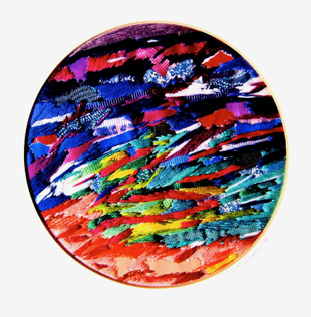
Sea Of Cortez, embroidered collage, 6″ x 6”
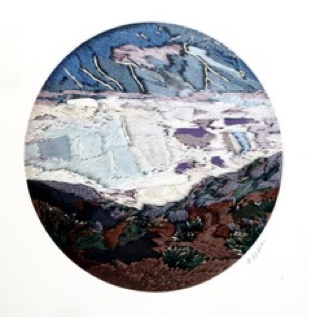
Salt Flats, Death Valley, embroidered collage, 6″ x 6”
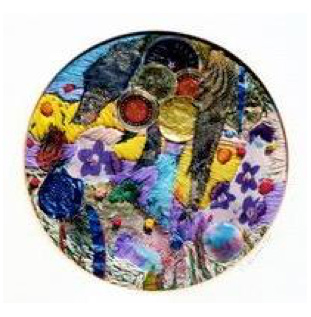
Bangkok Garden, embroidered collage,
6″ x 6”
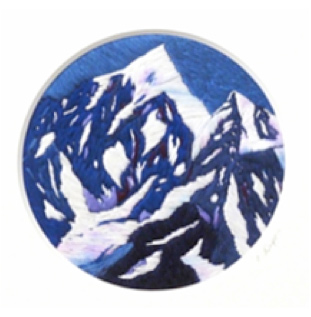
Over the Alps, embroidered collage, 6″ x 6”
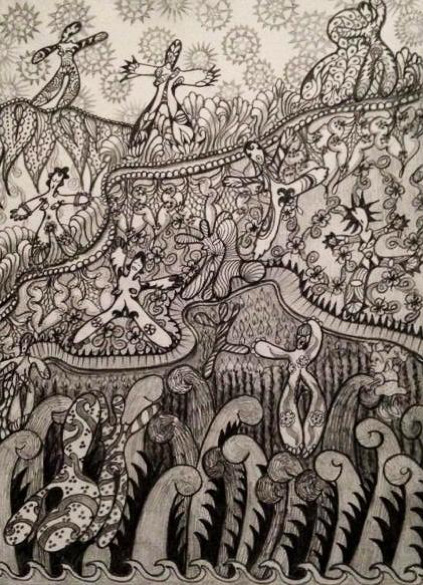
Carol Richard Kaufman, marking pen on paper, 20” x 16”
CAROLE RICHARD KAUFMAN
Artists see the world as art. People on the street, an alley of shapes and shadows. Intense feelings of seeing the “other” in foreign countries. Travelling through the Americas, Europe and Asia has sparked my creative juices and become the centerfold of my work. As an example, the Great Wall of China showed me the divide of a controlled society compared to our free one, but begs the question about the controls we put on ourselves and how the Chinese have found freedoms within theirs. Travel gives me food for thought (some very yummy and some very weird) and always new ideas for making art.
NATALIA KOREN KROPF
Travelling has been always exciting to me. The change of scenery and daily routine pushes one out of the comfort zone and probes the boundaries while travelling to a new place, while returning to a previously visited location can stir up memories and lend a deeper understanding of the whole experience of travelling.
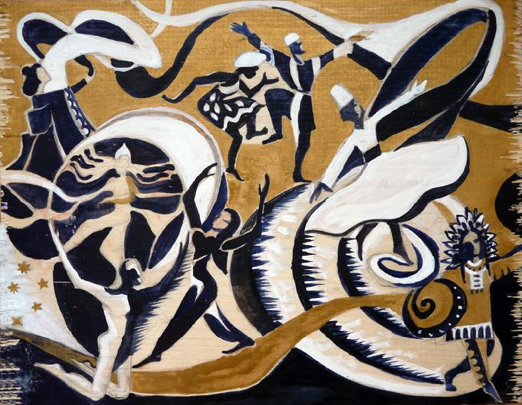
Natalia Koren Kropf, One Dance for Many Dancers, tempera on wood.
In the first case, I always carry a small sketchbook, a pocket watercolor set, and save all brochures and tickets to be incorporated into a collage later. And of course, I take a lot of pictures! This exploratory stage determines my interest and emotional ties to the place and captures the first impression. Great time for plein air painting, expressive gesture drawings and scrupulous visual and historical study.
Once I have an opportunity or a burning desire to return, I hardly sketch and take photos. I inhale the local air and mentally reconnect to all that I like – the colors, the sounds, the people, the spaces framed by architecture or nature.
Sometimes I work from memory if the initial encounter was particularly interesting. I may paint a portrait of an Amish field worker having seen him only briefly from a distance, or a lady I noticed in a cafe in Paris, or an antique bookseller in Amsterdam, or a museum guard in Berlin.
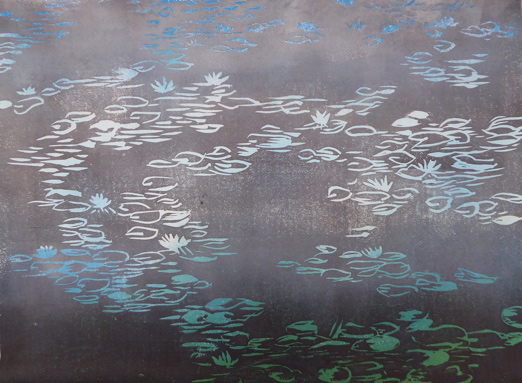
Natalia Koren Kropf, Black Silk, monoprint, 9” x 12”.
I return to some places in my dreams, feeling the spirit of a city and navigating the unknown yet well-known streets intuitively. I have made some paintings based on the feeling in these dreams.
Over time, I have discovered that all places become one. Its ethnic and geographical features aside, they have more similarities than differences. The formal elements compose themselves into a local tapestry in unique combinations, suggesting a mosaic, or a book of many colorful pages, or a dance for many dancers.
Being away is really about being yourself –a part of human history with a passport that makes you a Citizen of the World.
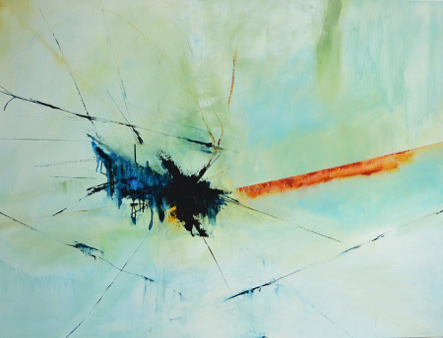
Anne Van Dyke, Decomposition #2, oil on canvas, 36” x 48”
ANNE VAN DYKE
I’m never really far from my art. No one is really far from her art. Art is a part of yourself. It is for me the expression of my creative skills and imagination in a visual form as a way to extract beauty and emotional strength.
Going away from my brushes and canvases for a while is a way to recharge my batteries and draw new energy. It is this new energy that will have an impact on my work. What really helps me is to stand in front of the sea for long hours, watching and listening carefully without saying anything because the sound of the waves and their natural strength takes me in a whirlwind of thoughts which empties my head and mind and fills it with positive energy. These thoughts are there, somewhere, sometimes a little hidden. But back in the studio, they quickly emerge. That’s art. That’s my art, never away from me.
EXHIBITS ON YOUR RADAR
Elizabeth A. Sackler Center for Feminist Art
Brooklyn Museum
Half the Picture: A Feminist Look at the Collection
August 23, 2018 – March 31, 2019
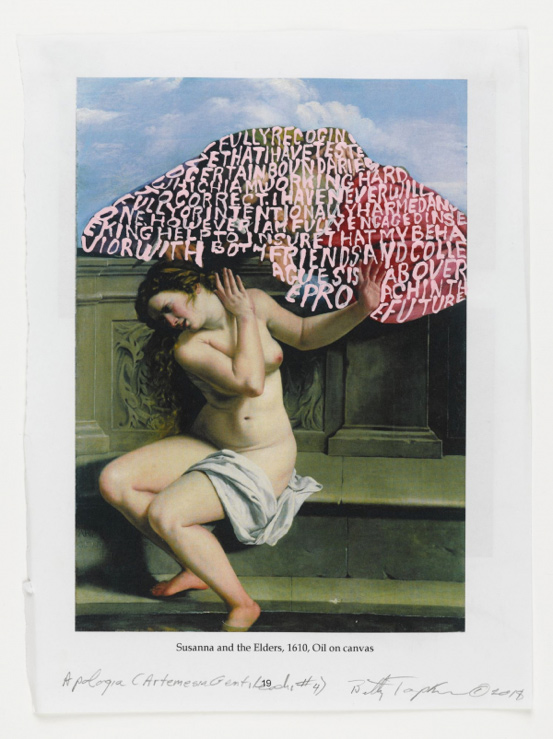
Betty Tompkins, Apologia (Artemisia Gentileschi #4), 2018, Acrylic on paper, Brooklyn Museum;
Elizabeth A. Sackler Center for Feminist Art, Emily Winthrop Miles Fund and Robert A. Levinson Fund,
© Betty Tompkins, photo: Jonathan Dorado, Brooklyn Museum.
Featuring more than 100 works from this collection, Half the Picture: A Feminist Look at the Collection explores a wide range of art-making, focusing on enduring political subjects—encompassing gender, race, and class—that remain relevant today. The exhibition’s intersectional feminist framework highlights artworks, in a plurality of voices, that aim to rally
support or motivate action on behalf of a cause, or to combat stereotypes and dominant narratives.
Half the Picture draws its title from a 1989 Guerrilla Girls poster that declares, “You’re seeing less than half the picture without the vision of women artists and artists of color.” Spanning almost one hundred years, the exhibition focuses on historical and contemporary work by more than fifty artists who combine message and medium to engage with political and social issues. Often radical and inspiring, these artists advocate for their communities, their beliefs, and their hopes for equality amid popular or state-supported opposition.
NAWA is happy to encourage the outstanding work of Catherine Morris, Sackler Senior Curator and Carmen Hermo, Associate Curator.
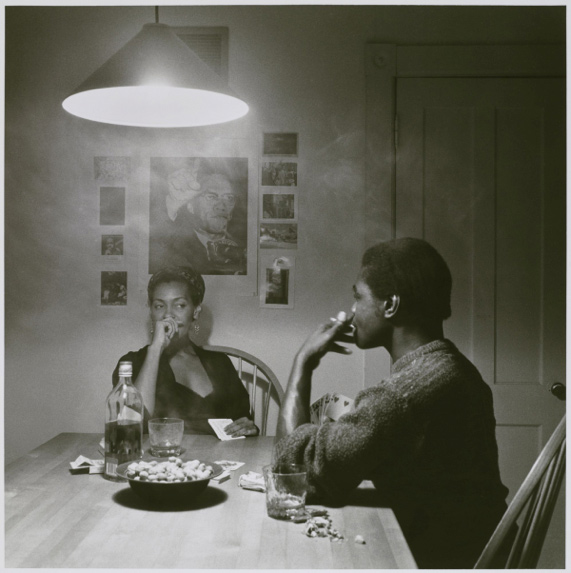
Carrie Mae Weems, Untitled (Man Smoking/Malcolm X), from the Kitchen Table Series, 1990 Gelatin silver photograph, Brooklyn Museum; Caroline Pratt Fund, © Carrie Mae Weems
RECENT MEMBER SOLO AND TWO-PERSON EXHIBITS
Penny Dell and Suprina
Womenswork.art
Summer Punch
4 South Clinton Street, Poughkeepsie, NY
June 16 & 17, 2018
Carole P. Kunstadt
Solo Exhibition
Scripted
Union Arts Center
2 Union Street
Sparkhill, NY
July – September 30, 2018
Nancy T. Lent
Solo Retrospective
Then and Now
Womenswork.art
4 South Clinton Street, Poughkeepsie, NY
June 16 & 17, 2018
Miriam Untoria and Mildred Kaye
Between Friends
Monroe Art Center, 720 Monroe Street #208, Hoboken, NJ
July 27 – August 18, 2018
STATE EXHIBITION
Phyllis Shenny
2018 Passaic Senior Art Show
Department of Senior Services, 930 Riverview Ave. Suite 200, Totowa, NJ
June 11 – June 29, 2018
Winner in the Digital category and Best in Show. Winning artwork will be exhibited at the NJ Sate Art show.
CURRENT/UPCOMING MEMBER SOLO AND TWO-PERSON EXHIBITS
Carol Nipomnich Dixon
Solo Exhibition
The People’s United Bank
146 Sound Beach Avenue, Old Greenwich, CT
September 1 – October 31, 2018
Reception: October 3, 5:00 – 7:00 pm
Solo Exhibition
The Medical Building Gallery
49 Lake Avenue, Greenwich, CT
September 1 – October 31, 2018
Ruth Bauer Neustadter
Turn the Tide
Hackensack Performing Arts Center Gallery
102 State Street, Hackensack, NJ
October 1 – November 15, 2018
Reception: Thursday, October 25, 2018
Mary Alice Orito
My Menagerie
Cawz for Pawz Thrift Boutique Pop-up Gallery
333 First Avenue, NYC
November 12, 2018, 4:00 – 8:00 pm
Alice Stoler
Vistas Revisited
Solo exhibition of recent abstract landscapes
Princeton Medical Center
1 Plainsboro Road, Plainsboro, New Jersey
July 10 – October 30, 2018
Reception: July 20, 2018, evening
Abby Zonies
The Liberation Series
Saint Peter’s Church
619 Lexington Ave, NYC
January 10 – March 21, 2019
Reception: TBA
CO-EDITORS SANDRA AND MIMI
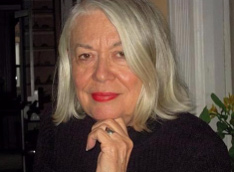
Sandra Bertrand
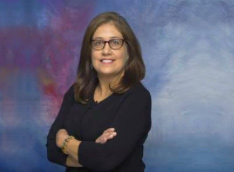
Mimi Herrera-Pease
A MESSAGE FROM YOUR CO-EDITORS SANDRA AND MIMI:
We hope you’ve enjoyed reading our October issue. Your interest and participation in those matters relevant to our membership will continue to make NAWA Now a stimulating experience for all of us. We welcome your news and ideas for future issues. Remember, this newsletter is for you and about you. That’s our commitment—to continue to make visible the important art you create throughout our network.
BUT, in order for us to keep that promise to you, we ask that you submit by the deadlines for each quarterly issue. To be considered for our upcoming January 2019 issue, we must receive your information by December 15. Any material received after that time will be considered for the following issue.
When submitting notices about solo and two-person shows, you must include title of exhibit, venue, address, and dates of show as well as reception. If artwork is being submitted, you must indicate work’s title, medium, size and date. If you have any questions about your exhibition’s eligibility for listing, for instance, a national or state-wide biennial or triennial or national or international art fair, please contact us.
Most importantly, 2019 is our Anniversary Year. We ask that you continue to visit the NAWA website, to keep up to date on all the exhibits and activities planned throughout the coming year. As an active member, we encourage you to promote our organization among your own arts community. We have a proud history and with your help, an amazing future.



